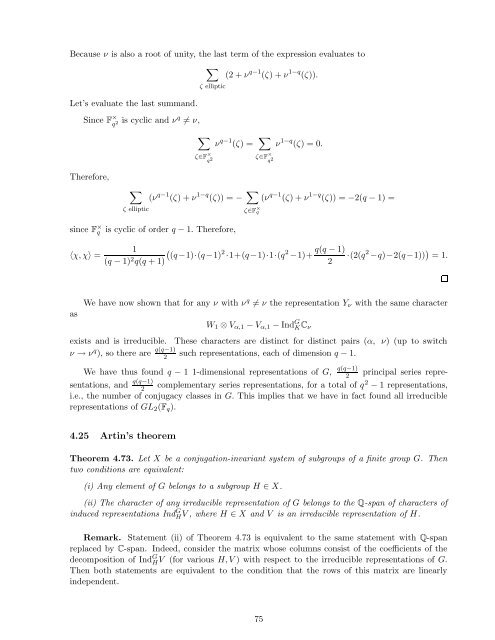Lecture notes for Introduction to Representation Theory
Lecture notes for Introduction to Representation Theory
Lecture notes for Introduction to Representation Theory
Create successful ePaper yourself
Turn your PDF publications into a flip-book with our unique Google optimized e-Paper software.
Because λ is also a root of unity, the last term of the expression evaluates <strong>to</strong><br />
<br />
(2 + λ q−1 (ψ) + λ 1−q (ψ)).<br />
Let’s evaluate the last summand.<br />
Since F × is cyclic and λ q = ⇒ λ,<br />
q 2<br />
λ elliptic<br />
<br />
λ q−1 (ψ) = λ 1−q (ψ) = 0.<br />
There<strong>for</strong>e,<br />
λF ×<br />
q 2 λF ×<br />
q 2<br />
<br />
(λ q−1 (ψ) + λ 1−q (ψ)) = − (λ q−1 (ψ) + λ 1−q (ψ)) = −2(q − 1) =<br />
λ elliptic λF ×<br />
q<br />
since F × is cyclic of order q − 1. There<strong>for</strong>e,<br />
q<br />
1 ⎩<br />
2 2<br />
ν, ν = (q − 1)<br />
2 (q −1) (q −1)<br />
2<br />
1+(q −1) 1 (q −1)+ q(q − 1) <br />
◦ · · · · ·(2(q<br />
−q)−2(q −1)) = 1.<br />
q(q + 1) 2<br />
as<br />
We have now shown that <strong>for</strong> any λ with λ q = ⇒ λ the representation Y ξ with the same character<br />
W 1 V ,1 − V ,1 − Ind G<br />
K C ξ<br />
exists and is irreducible. These characters are distinct <strong>for</strong> distinct pairs (ϕ, λ) (up <strong>to</strong> switch<br />
λ ⊃ λ q ), so there are q(q−1) such representations, each of dimension q − 1.<br />
2<br />
We have thus found q − 1 1-dimensional representations of G, q(q−1) 2<br />
principal series representations,<br />
and q(q−1) complementary series representations, <strong>for</strong> a <strong>to</strong>tal of q2<br />
2<br />
− 1 representations,<br />
i.e., the number of conjugacy classes in G. This implies that we have in fact found all irreducible<br />
representations of GL 2 (F q ).<br />
4.25 Artin’s theorem<br />
Theorem 4.73. Let X be a conjugation-invariant system of subgroups of a finite group G. Then<br />
two conditions are equivalent:<br />
(i) Any element of G belongs <strong>to</strong> a subgroup H X.<br />
(ii) The character of any irreducible representation of G belongs <strong>to</strong> the Q-span of characters of<br />
induced representations Ind G H V , where H X and V is an irreducible representation of H.<br />
Remark. Statement (ii) of Theorem 4.73 is equivalent <strong>to</strong> the same statement with Q-span<br />
replaced by C-span. Indeed, consider the matrix whose columns consist of the coefficients of the<br />
decomposition of Ind G H V (<strong>for</strong> various H, V ) with respect <strong>to</strong> the irreducible representations of G.<br />
Then both statements are equivalent <strong>to</strong> the condition that the rows of this matrix are linearly<br />
independent.<br />
75

















